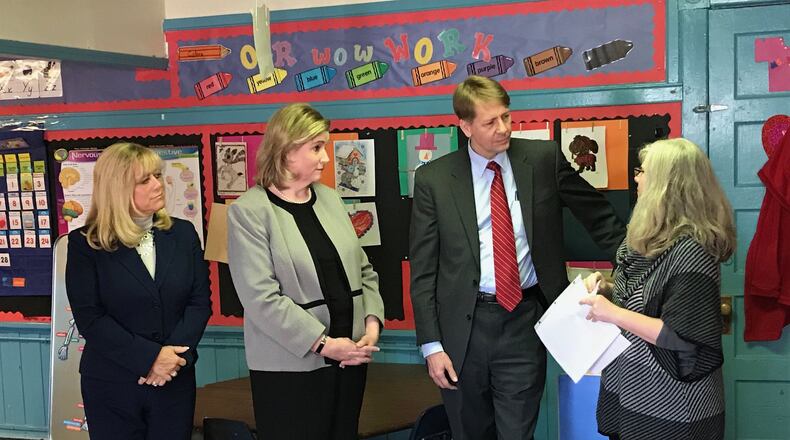RELATED: Preschool advocates say state budget cut is tolerable
State funding for early childhood education went down 1 percent in the last budget just after voters in Dayton and Cincinnati approved local tax funding to boost their own programs. Cordray lit into state leaders about that.
“This is exactly the problem in the state of Ohio,” Cordray said. “You have a state legislature that has this mania for giving more tax cuts to the rich. And all of that money comes out of local services and programs. First responders, in this case schools – the local communities are being hurt to fund an ideological agenda in Columbus and it’s not good for the state of Ohio.”
Cordray participated Monday in a roundtable discussion on early-childhood education, featuring local preschool owners, policy experts and parents, as well as Dayton Mayor Nan Whaley and Montgomery County Commissioner Debbie Lieberman, who have been vocal leaders of the Preschool Promise effort.
RELATED: Governor candidates argue over drugs, mental health, more
Preschool providers talked about the challenges of finding and paying quality staff and navigating complex state funding models, while parents said tuition assistance from Preschool Promise had been crucial in sending their children to high-quality, full-day preschool or child care, so they could work.
Jama Hardern owns and operates the Rainbow Years Child Care center in East Dayton where Cordray visited Monday. She showed him detailed lesson plans from teachers at the five-star center who have college degrees but aren’t paid as well as Hardern said they should be.
Cordray praised the Dayton area’s early-childhood education push and said Ohio needs to figure out how to prioritize its budget so that it can start helping students at earlier ages. Lieberman said Montgomery County’s work could be replicated, but said there needs to be more of a funding partnership with state and federal officials.
EDUCATION NEWS: Follow Jeremy Kelley DDN on Facebook and Twitter
Cordray cited a long-term link, saying the percentage of students not ready for kindergarten is roughly the same percentage who 13 years later are not ready for the workforce, creating a crucial problem.
Cordray said the state needs to examine school funding, adding that the primary property tax model still produces inequality among communities. Addressing school security, he supported a Fraternal Order of Police statement calling for screening at secured school entrances, as well as use of armed resource officers who can both respond to crises, but also build day-to-day relationships with students.
The Democratic candidates for governor in the May 8 primary election are Cordray, Joe Schiavoni, Dennis Kucinich, William O’Neill, Larry Ealy and Paul Ray. On the Republican side, Attorney General Mike DeWine is running against Lt. Gov. Mary Taylor.
RELATED: Whaley drops out of governor race, backs Cordray
ELECTION 2018
Get the latest news on the race for governor on our Ohio Politics Facebook page. Follow our team on Twitter at @Ohio_Politics
About the Author

